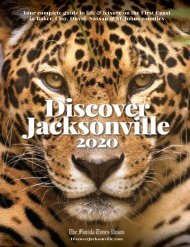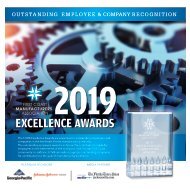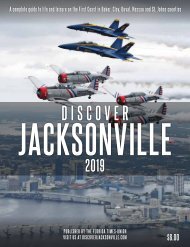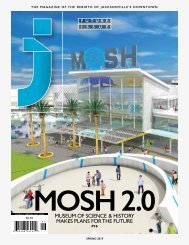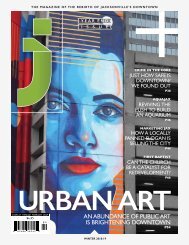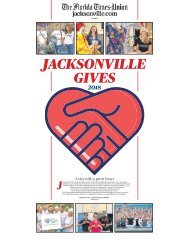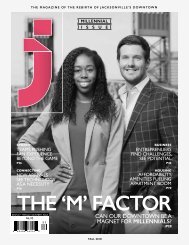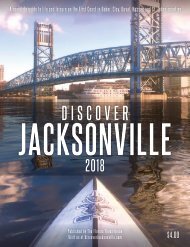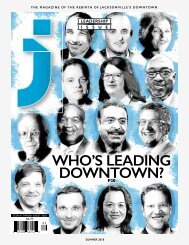J Magazine Spring 2018
Create successful ePaper yourself
Turn your PDF publications into a flip-book with our unique Google optimized e-Paper software.
that money will be used to replace trees on public property lost<br />
to development, storms and disease, November said.<br />
The funds also can be used to add new trees — Downtown.<br />
Figuring out what to do<br />
So, there’s money and expertise available, but what sorts of<br />
things could be done?<br />
The Late Bloomers Garden Club is advocating for a master plan<br />
for what it calls the Core District, stretching from City Hall to the<br />
river and bounded by Hogan and Laura streets. The vision includes<br />
a revamped Hemming Park and “a landmark public park on the<br />
riverfront central to Downtown.” And with the city contemplating<br />
moving Metropolitan Park, the Late Bloomers’ idea has possibilities.<br />
Erik Aulestia, the Cathedral District master planner, suggests<br />
that some of the countless parking lots scattered across Downtown<br />
could be turned into park space. He also recommended trees<br />
and landscaping along streets, which would give residential areas<br />
Downtown a “homey” feel.<br />
Buck Pittman, the landscape architect, would start with the<br />
streetscape.<br />
“You have to build from outside in,” he said. “There needs to be a<br />
committed effort. That’s what it’s going to take to make spaces green<br />
and attractive to walk through and to attract businesses.<br />
“You need some private incentives, too. That would encourage<br />
private property owners to do more landscaping their own property.”<br />
He likes what Greenville, S.C., did. They converted their streets<br />
to two-way, which slows down traffic and opens up more space to<br />
widen sideways and allow more trees.<br />
Larry Figart, urban forestry agent for Duval County Extension,<br />
would like to see an urban forest master plan.<br />
“Cities that have dynamic urban forestry programs treat trees<br />
as part of the infrastructure, just like sewers and sidewalks. When<br />
something gets redeveloped, trees are part of that, not an afterthought.”<br />
He’s a big advocate of planting the right tree in the right place,<br />
considering factors like how big the tree grows, how long it lives and<br />
how much sun and water it needs.<br />
That hasn’t been happening in Downtown, Figart said, judging<br />
from the live oaks and date palms planted in the street scape.<br />
The date palms, which you’ll see along Riverside and Bay streets,<br />
are meant to be grown in hot, dry climates like Southern California.<br />
They’re pretty trees but palms native to Florida would be a better<br />
choice. But Figart doesn’t think palms are a good choice because<br />
they are expensive, high-maintenance trees.<br />
Live oaks grow into huge trees — like the Treaty Oak — with<br />
sprawling root systems. But in Downtown Jacksonville, they are<br />
planted in curbside pits that don’t allow for proper growth. Savannah’s<br />
streetscape gives their oaks the space they need.<br />
Whatever trees are chosen for Downtown, they must be tough.<br />
Urban cores are inhospitable places for trees — roads, sidewalks<br />
and underground utilities that restrict water, air flow and root<br />
growth. Over time tree roots can do serious damage to underground<br />
pipes.<br />
One way to provide more trees Downtown is with parks, which<br />
allow for groupings of trees, as well as bigger, shade-producing<br />
trees, Figart said.<br />
Chris Daily, horticultural director at the Jacksonville Zoo and<br />
Gardens, said the critical factor to any green space plan is maintenance.<br />
Daily is advising Boyer on the pocket parks along the Riverwalk.<br />
“You can spend thousands of dollars on the plants and the design<br />
but if you don’t take care of it, what’s the point,” he said. “It<br />
takes people with the right mindset. You can’t mow and blow. It’s a<br />
hands-on job and you need a certain level of knowledge.”<br />
The zoo has 14 horticulturists on staff and every garden has a<br />
horticulturist assigned to it who monitors the space daily. In addition<br />
to the needs of the plants, they deal with trash, vandalism and<br />
damage inflicted by throngs of people.<br />
He also recommends spending the money to buy healthy, wellformed<br />
trees. “If they’re cheap, they’re cheap for a reason,” Daily<br />
said. “If they’re poorly grown, root bound or have structural issues,<br />
they’re not going to last.”<br />
Having a plan<br />
Trees and green space are an important part of the redevelopment<br />
of Downtown. They can help shape its identity, improve its<br />
environment and a catalyst for investment.<br />
But the green space needs to be done with forethought. There<br />
needs to be a plan, a big picture of a chain of parks from the riverfront,<br />
through Downtown linking the various Downtown district<br />
from the riverfront to the Emerald Necklace.<br />
It’s a critical piece of making Downtown a welcoming place and<br />
give people another reason to come Downtown to live, work and play.<br />
Lilla Ross is a freelance writer in Jacksonville. She worked for The Florida Times-<br />
Union for more than 30 years as a writer and editor. She lives in San Marco.<br />
SPRING <strong>2018</strong> | J MAGAZINE 47



